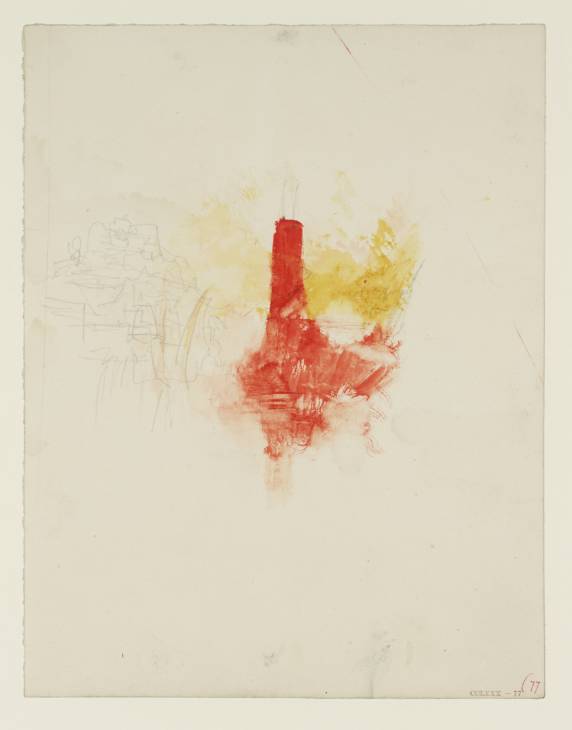Joseph Mallord William Turner Vignette Study for Moore's 'The Epicurean'; Pharos (The Scarlet Tower) c.1837-8
Joseph Mallord William Turner,
Vignette Study for Moore's 'The Epicurean'; Pharos (The Scarlet Tower)
c.1837-8
Joseph Mallord William Turner 1775–1851
Vignette Study for Moore’s ‘The Epicurean’; Pharos (The Scarlet Tower) circa 1837–8
D27594
Turner Bequest CCLXXX 77
Turner Bequest CCLXXX 77
Pencil and watercolour, approximately 120 x 130 mm on board, 228 x 179 mm
Inscribed by John Ruskin in red ink ‘(77’ bottom right
Stamped in black ‘CCLXXX 77’ bottom right
Inscribed by John Ruskin in red ink ‘(77’ bottom right
Stamped in black ‘CCLXXX 77’ bottom right
Accepted by the nation as part of the Turner Bequest 1856
Exhibition history
1974
Turner 1775–1851, Royal Academy, London, November 1974–March 1975 (298).
1976
J.M.W. Turner 1775–1851: Akvareller og Tegninger fra British Museum, Statens Museum for Kunst, Copenhagen, February–May 1976 (no.40).
1976
William Turner und die Landschaft seiner Zeit, Hamburger Kunsthalle, May–July 1976 (59, reproduced).
1977
Turner Watercolors: An Exhibition of Works Loaned by The Trustees of the British Museum, International Exhibitions Foundation tour, Cleveland Museum of Art, September–November 1977, Detroit Institute of Arts, December 1977–February 1978, Philadelphia Museum of Art, March–April 1978 (56, reproduced in colour).
1989
Colour into Line: Turner and the Art of Engraving, Tate Gallery, London, October 1989–January 1990 (84, reproduced).
References
1909
A.J. Finberg, A Complete Inventory of the Drawings in the Turner Bequest, London 1909, vol.II, p.894, as ‘The scarlet tower’.
1974
Martin Butlin, Andrew Wilton and John Gage, Turner 1775–1851, exhibition catalogue, Royal Academy, London 1974, p.101 no.298 as ‘A Scarlet Tower – Study for a Vignette’.
1976
Werner Hofmann, Andrew Wilton, Siegmar Hosten and others, William Turner und die Landschaft seiner Zeit, exhibition catalogue, Hamburger Kunsthalle 1976, p.127 no.59, reproduced, as ‘Ein scharlachroter Turm – Studie zu einer Vignette’ [A Scarlet Tower – Study for a Vignette].
1976
David Loshak and Andrew Wilton, J.M.W. Turner 1775–1851: Akvareller og Tegninger fra British Museum, exhibition catalogue, Statens Museum for Kunst, Copenhagen 1976, no.40, as ‘A Scarlet Tower – Study for a Vignette’.
1977
Andrew Wilton, Turner Watercolors: An Exhibition of Works Loaned by The Trustees of the British Museum, exhibition catalogue, Cleveland Museum of Art 1977, pp.14, 74–5 no.56, reproduced (colour), as ‘A Scarlet Tower: Study for a Vignette’.
1989
Anne Lyles and Diane Perkins, Colour into Line: Turner and the Art of Engraving, exhibition catalogue, Tate Gallery, London 1989, no.84, p.78, reproduced as ‘Study for Vignette’.
1993
Jan Piggott, Turner’s Vignettes, exhibition catalogue, Tate Gallery, London 1993, p.96 as ‘Pharos, in palette of T[homas] M[oore] designs’.
Popularly known as The Scarlet Tower, this brilliantly coloured vignette design has been identified by Jan Piggott as a study of the tower of Pharos at Alexandria for Thomas Moore’s fantastical prose tale, The Epicurean.1 Moore’s hero, Alciphron, sees the great rock and tower of Pharos upon his arrival in the Egyptian city:
and at length, as the morning freshly broke, we saw the beautiful city of Alexandria rising from the sea, with its proud Palace of Kings, its portico of four hundred columns, and the fair Pillar of Pillars, towering in the midst to heaven. After passing in review this splendid vision, we shot rapidly round the Rock of Pharos, and, in a few minutes, found ourselves in the harbour of Eunostus. The sun had risen, but the light on the Great Tower of the Rock was still burning; and there was a languor in the first waking movements of that voluptuous city – whose houses and temples lay shining in silence around the harbour
(Thomas Moore, The Epicurean, 1839, pp.15–6)
(Thomas Moore, The Epicurean, 1839, pp.15–6)
The study differs dramatically from another view of Pharos that Turner made for Moore’s tale, which, like many of Turner’s preliminary studies for The Epicurean, is a pencil drawing overlaid with delicate pastel washes (see Tate D27633; Turner Bequest CCLXXX 116). By contrast, the tower here is delineated by intense colour.
Anne Lyles and Diane Perkins have linked the distinctive chromatic pairing of bright yellow and red of the study to another work, also thought to be a preparatory design for the Moore’s series (see Tate D27599; Turner Bequest CCLXXX 82).2 The similar execution of these two works suggests that they were almost certainly produced at around the same time and for the same project. Both studies were previously identified with Turner’s illustrations to Campbell’s Poetical Works, published by Moxon in 1837.3 However, the 1837 watermark on Pharos discounts this identification, since Turner finished his illustrations for Campbell’s Works no later than 1836.
The vibrant palette of both studies is particularly striking given that the illustrations were designed to be translated into monochrome engravings. Turner often deliberately employed bright colours in order to encourage his engravers to translate the spirit and effects of his compositions.4 His use of large areas of contrasting colour would have helped engravers to convert the tonal aspects of the composition into black and white.5
Technical notes:
Watermark ‘SE & Co 1837’
Watermark ‘SE & Co 1837’
Verso:
Inscribed by an unknown hand in pencil ‘CCLXXX 77’ bottom right
Meredith Gamer
August 2006
How to cite
Meredith Gamer, ‘Vignette Study for Moore’s ‘The Epicurean’; Pharos (The Scarlet Tower) c.1837–8 by Joseph Mallord William Turner’, catalogue entry, August 2006, in David Blayney Brown (ed.), J.M.W. Turner: Sketchbooks, Drawings and Watercolours, Tate Research Publication, December 2012, https://www

